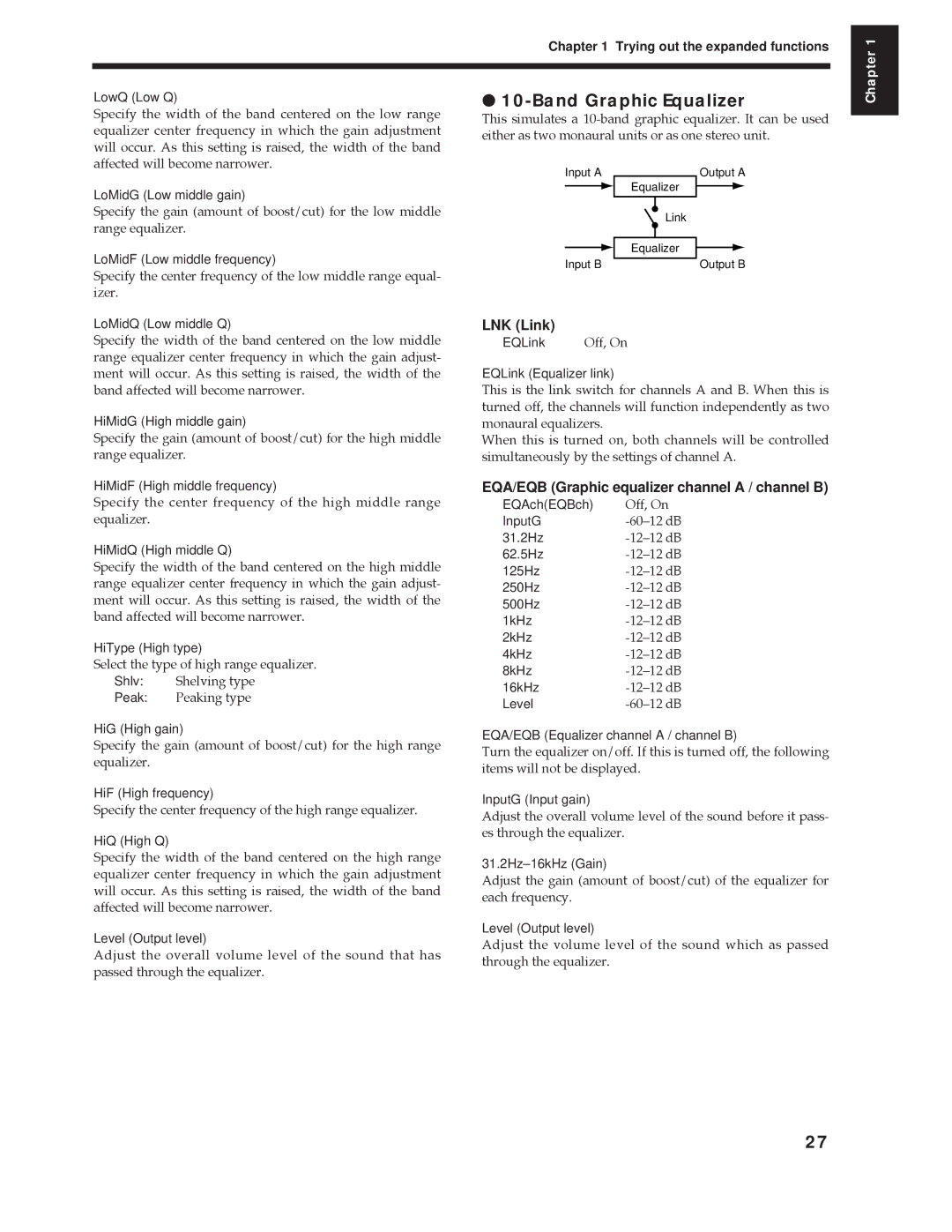
| Chapter 1 Trying out the expanded functions | |||||||
|
| |||||||
|
| |||||||
LowQ (Low Q) | ● | |||||||
Specify the width of the band centered on the low range | This simulates a | |||||||
equalizer center frequency in which the gain adjustment | ||||||||
either as two monaural units or as one stereo unit. | ||||||||
will occur. As this setting is raised, the width of the band | ||||||||
|
|
|
|
|
|
| ||
affected will become narrower. | Input A |
|
| Output A | ||||
|
|
| ||||||
LoMidG (Low middle gain) |
|
|
| Equalizer |
|
| ||
|
|
|
|
| ||||
|
|
|
|
|
|
| ||
Specify the gain (amount of boost/cut) for the low middle |
|
|
|
| Link | |||
|
|
|
| |||||
range equalizer. |
|
|
|
| ||||
|
|
|
|
|
|
| ||
LoMidF (Low middle frequency) |
|
|
| Equalizer |
|
| ||
Input B | Output B | |||||||
|
| |||||||
|
| |||||||
|
|
| ||||||
Specify the center frequency of the low middle range equal- izer.
Chapter 1
LoMidQ (Low middle Q)
Specify the width of the band centered on the low middle range equalizer center frequency in which the gain adjust- ment will occur. As this setting is raised, the width of the band affected will become narrower.
HiMidG (High middle gain)
Specify the gain (amount of boost/cut) for the high middle range equalizer.
HiMidF (High middle frequency)
Specify the center frequency of the high middle range equalizer.
HiMidQ (High middle Q)
Specify the width of the band centered on the high middle range equalizer center frequency in which the gain adjust- ment will occur. As this setting is raised, the width of the band affected will become narrower.
HiType (High type)
Select the type of high range equalizer.
Shlv: Shelving type
Peak: Peaking type
HiG (High gain)
Specify the gain (amount of boost/cut) for the high range equalizer.
HiF (High frequency)
Specify the center frequency of the high range equalizer.
HiQ (High Q)
Specify the width of the band centered on the high range equalizer center frequency in which the gain adjustment will occur. As this setting is raised, the width of the band affected will become narrower.
Level (Output level)
Adjust the overall volume level of the sound that has passed through the equalizer.
LNK (Link)
EQLink | Off, On |
EQLink (Equalizer link)
This is the link switch for channels A and B. When this is turned off, the channels will function independently as two monaural equalizers.
When this is turned on, both channels will be controlled simultaneously by the settings of channel A.
EQA/EQB (Graphic equalizer channel A / channel B)
EQAch(EQBch) | Off, On |
InputG | |
31.2Hz | |
62.5Hz | |
125Hz | |
250Hz | |
500Hz | |
1kHz | |
2kHz | |
4kHz | |
8kHz | |
16kHz | |
Level |
EQA/EQB (Equalizer channel A / channel B)
Turn the equalizer on/off. If this is turned off, the following items will not be displayed.
InputG (Input gain)
Adjust the overall volume level of the sound before it pass- es through the equalizer.
Adjust the gain (amount of boost/cut) of the equalizer for each frequency.
Level (Output level)
Adjust the volume level of the sound which as passed through the equalizer.
27
